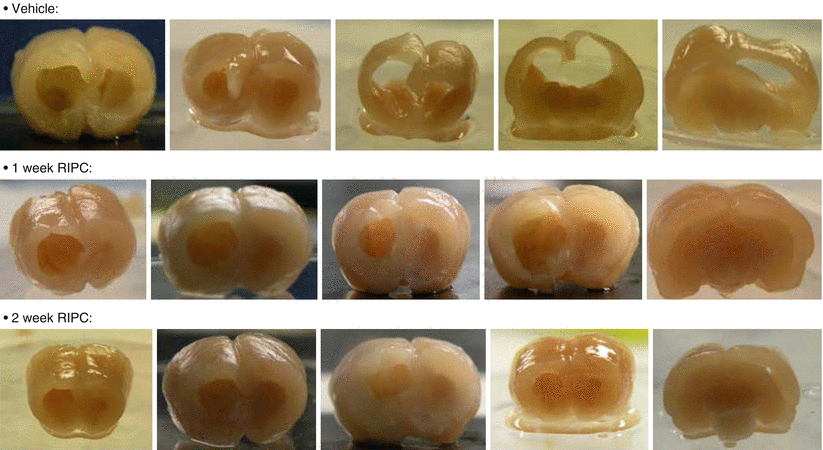Fig. 1
Water-maze analysis at one month after GMH. Animals were tested using progressive levels, from cued to spatial trials. (*) <0.05 compared with sham; (#) <0.05 compared with vehicle. Data expressed as standard error of mean; n = 10–12/group

Fig. 2
Ventricular area (extent of hydrocephalus) at 1 month after GMH. (*) < 0.05 compared with vehicle. Data expressed as standard error of mean; n = 6–8/group

Fig. 3
Pictographs showing relative cortical thickness and ventricular and overall brain size between groups
Conclusion
Translational stroke studies, in particular animal modeling, are greatly needed to safely integrate basic preclinical scientific principles ahead of clinical application [26–30]. This study, in summary, showed that treatment with RIPC is a safe and noninvasive approach and this animal model demonstrated improved sensorimotor and neuropathological outcomes following GMH in rats. Further studies are needed to evaluate the actual mechanisms of RIPC neuroprotection.
Acknowledgment
This study was partially supported by the National Institutes of Health grant RO1 NS078755 (Dr Zhang).
Disclosures
None
References
1.
Ballabh P (2010) Intraventricular hemorrhage in premature infants: mechanism of disease. Pediatr Res 67:1–8PubMedCentralCrossRefPubMed
2.
3.
Chen Q, Zhang J, Guo J, Tang J, Tao Y, Li L, Feng H, Chen Z (2014) Chronic hydrocephalus and perihematomal tissue injury developed in a rat model of intracerebral hemorrhage with ventricular extension. Transl Stroke Res. doi:10.1007/s12975-014-0367-5
4.
Zhao J, Chen Z, Xi G, Keep RF, Hua Y (2014) Deferoxamine attenuates acute hydrocephalus after traumatic brain injury in rats. Transl Stroke Res 5:586–594PubMedCentralCrossRefPubMed
5.
6.
Uria-Avellanal C, Robertson NJ (2014) Na(+)/H(+) exchangers and intracellular pH in perinatal brain injury. Transl Stroke Res 5:79–98. doi:10.1007/s12975-013-0322-x PubMedCentralCrossRefPubMed
7.
8.
Keep RF, Wang MM, Xiang J, Hua Y, Xi G (2014) Full steam ahead with remote ischemic conditioning for stroke. Transl Stroke Res 5:535–537PubMedCentralCrossRefPubMed









